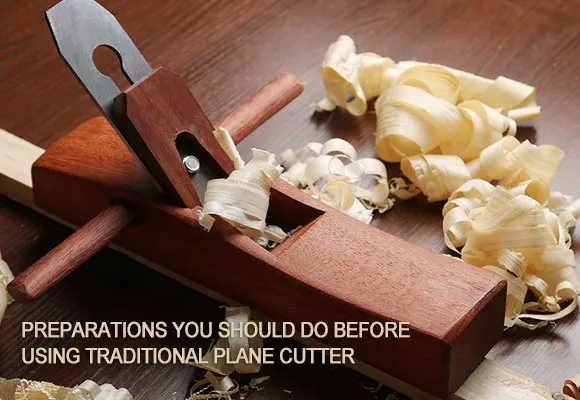
Preparations You Should Do Before Using Traditional Plane Cutter
No matter whether you are a wood processing worker, a woodworking enthusiast, or a fresh hand in woodworking, you must know the tool we will introduce today—the traditional plane cutter. We should know that when we plane wood board we are not just going to press all our strength on our tools and then push it. In fact, there are more things you should know about planing, which means you need to do some preparations before using a traditional plane cutter.

Adjustment of traditional planer blade
When you install your plane blades, you have to pay attention to the distance between your planer blade and cover iron.
Secondly, the edge of the blade should be close to the bottom of the planer cutter. Then, add your wedge, press it slightly down, hold left corner of the planer bottom with your left hand and hold the wedge, cover the iron, and planer blade.
Next, you need to correct the cutting edge with a hammer until the cutting edge gets out of the plane crumbs slot(to correct the cutting edge is because the exposure of the cutting edge is proportional to the amount of planing. With more exposure to your blade, there will be more planing volume. Rough planing should be exposed more and fine planing should be exposed less. To check the exposure of the planer blade, you can hold your planer cutter with your left hand. Put its bottom face up and check its blade with one eye. You need to tap the top of the planer blade if the exposed part is not enough, and if the blade extends too much, you need to tap the end of your plane and make it go back. If one corner of the cutting edge is prominent, just tap the upper side at the same angle.

Shape of blades
For most planer cutters, their blade edges should be ground into a shape of gibbosity, and for different uses of planer cutters, the difference is the scale of protruding. A plane cutter used for rough processing or for cutting thick plank has a larger protruding part. You can see the curvature directly. Its purpose is to eliminate the interference of uneven planer blades and cut the plate more efficiently. After rough processing, we should use a fine plane to flatten and smooth the surface, and the fine plane should be flat in the ideal. However, due to the user’s experience and quality limit, it is best to be ground into a micro convex top, which is very small and can only be checked out with the help of tools. The fine planer cutter body should be slightly wider, and the bottom of the planer cutter should be flat. The gap between blade and notch should be very small.
Main points of using a traditional planer cutter
First, planing quality is related to the length of the planer cutter and planing bottom flatness. if there is an uneven situation, then we should check whether there is a problem with the hardware of our planers.
Secondly, the way of planing also affects efficiency. The general planing procedure is as follows.
1. Transverse planing from the head of the board.
2. Diagonal planing on the board face.
3.Planing along the wood grain.
4. Fine planing and sleeking work pieces.
Thirdly, feeding direction. Forward feed is always suggested to a new hand. But we should always remember that the body of our planer should always be the same direction to travel direction, so as to avoid stubble possibility.
Fourthly, operation of planing.
When planing, you need to press planing body by using two index finger and should press the back of planing blade with your thumb, and your other fingers and palm need to hold the handle tightly. Planer should be flat and evenly applied to both of your hands. When pushing forward, two thumbs need to use more strength, and two index fingers slightly add pressure. When pushing to the front of your workpiece, pressure should be decreased gradually until there is no pressure. When turning back, the hand behind your plane should be slightly raised, so as not to drag your blade on the wood surface, which is easy to make the blade get dull.
When planing materials with long lengths, we should first check the plane whether it is inside material or outside material. The general way to distinguish is the texture of the surface of the material. Usually, the inside material is cleaner than the outside material, and the inside material has a clearer texture. If it is inside material, planing should be done from root to top of the workpiece. Otherwise, the wood should be done from its top to its root. Cutting along the direction of the wood texture, you can get a more labor-saving planing experience.
Now you know what we should do before cutting our wood boards before using a planer cutter. Have you ever noticed these things before you plane your project? If not, you can do these things now.